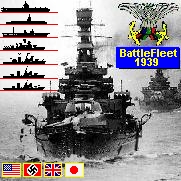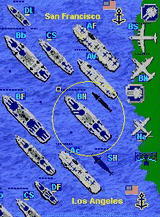List of
German Navy Ships WW2
Battleship Bismarck,
Graf
Zeppelin
Battleships Tirpitz,
Scharnhorst Admiral
Graf Spee U-Boats
Types 1, 2A, 2B, 2C, 2D
Kriegsmarine
Submarines Types U-Flak, 7A, 7B, 7C,
7C/41, 7C/42, 7D, 7F Kriegsmarine
Submarines: U-Boats Type 9A,
9B, 9C, 9C/40, 9D, 14
Submarines: Type
XXI , Type XXIII
Grand Admiral Karl
Donitz, Erich RaederHMS Prince
of Wales Battleship, HMS Repulse HMS Ark
Royal, HMS Hood
Battlecruisers Battle of
Crete - Operation Mercury
WW2 Battle
of Taranto
Battle of
Cape Matapan Battle of
Narvik Battle of the River
Plate,
Battle of Dunkirk,
Battle of the Atlantic
Battleship Game - WW2 Naval
Strategy: No1 Battleship Game for PC and No3 Aircraft Carrier Game on World Net
Missions and Scenarios:
Pearl Harbor Game
Atlantic Game 1943
Sink Cruisers Game
Midway Game
Iwo Jima Game
US Marines Game
Luftwaffe Game Pacific
Torpedo Game Boats
Bismarck Game Pacific
Destroy RAF Game
Okinawa
Us Navy Submarine Game
Fleet Submarines Game
Kamikaze Game
U Boat Game
Singapore Game
Swordfish Hunt
Patrol Boats
Air Supremacy
Alert
Battleships Game
Java
Defense
Fleet Cruisers Game
Atlantic Island
Coral Sea Game
Iron Sea
Mykonos
Imperial Ocean
Long Convoy
Skagerrak
Target Los Angeles
West Pacific Game
Pacific War Game
Leyte Transport
Emperor Hirohito
Normandy Game
South Pacific Game
Destroy USAF Game
Submarine Games
US Navy Game
Free Hunt Doenitz Game
Free Hunt Spruance Game
Free Hunt Halsey Game
Imperial Navy I
Royal Navy Game
Free Hunt Pearl Harbor Games
Midway II
Kriegsmarine I
Brisbane Convoy
Clear West Coast
Fall Of Australia
Battle For Leyte
Conquer Of Japan
|
GESTAPO The Geheime Staatspolizei (German
for "secret state police"), commonly
abbreviated as Gestapo, formed the official state secret
police force of Nazi Germany.
Recruited from professional police officers, its role and
organisation was quickly established by Hermann G?ring
after Hitler gained power in March 1933. Rudolf Diels was
the first head of the organization, initially called
Department 1A of the Prussian State Police.
The role of the Gestapo was to investigate and combat
"all tendencies dangerous to the State." They
had the authority to investigate treason, espionage and
sabotage cases, and cases of criminal attacks on the
Party and State.
The Gestapo's actions were not restricted by the law or
subject to judicial review. The Nazi jurist, Dr. Werner
Best, stated, "As long as the [Gestapo]... carries
out the will of the leadership, it is acting
legally." The Gestapo was specifically exempted from
being responsible to administrative courts, where
citizens normally could sue the state to conform to laws.
The power of the Gestapo
most open to misuse was Schutzhaft or "protective
custody" - a euphemism for the power to imprison
people without judicial proceedings, typically in
concentration camps. The person imprisoned even had to
sign their own Schutzhaftbefehl (the document declaring
the person was to be imprisoned). Normally this signature
was forced by torture.
In 1934, G?ring, under pressure from Heinrich Himmler,
agreed to grant control of the Gestapo to the SS. In 1936
Reinhard Heydrich became head of the Gestapo and Heinrich
Muller chief of operations.
During World War II, the Gestapo was expanded to around
45,000 members. It helped control conquered areas of
Europe and identify Jews, Socialists, homosexuals and
others for transportation to camps.
Organization
When the Gestapo was founded, the organization was
already a well-established bureaucratic mechanism, having
been created out of the already existing Prussian Secret
Police. In 1934, the Gestapo was transferred from the
Prussian Interior Ministry to the authority of the SS,
and for the next five years the Gestapo underwent a
massive expansion.
In 1939, the entire Gestapo was placed under the
authority of the RSHA, a main office of the SS. Within
the RSHA, the Gestapo was known as "Amt IV".
The internal organization of the group was as follows:
[edit]
Referat N: Central Intelligence Office
The Central Command Office of the Gestapo, formed in
1941. Before 1939, the Gestapo command was under the
authority of the office of the Sicherheitspolizei und SD,
to which answered the Commanding General of the Gestapo.
Between 1939 and 1941, the Gestapo was run directly
through the overall command of the
Reichsicherheitshauptamt (RSHA).
[edit]
Department A (Enemies)
* Communists (A1)
* Countersabotage (A2)
* Reactionaries and Liberals (A3)
* Assassinations (A4)
Department B (Sects and Churches)
* Catholics (B1)
* Protestants (B2)
* Freemasons (B3)
* Jews (B4)
* Coloured People (B5)
Department C (Administration and Party Affairs)
The central administrative office of the Gestapo,
responsible for card files of all personnel.
Department D (Occupied Territories)
* Opponents of the Regime (D1)
* Churches and Sects (D2)
* Records and Party Matters (D3)
* Western Territories (D4)
* Counter-espionage (D5)
Department E (Counter-Intelligence)
* In the Reich (E1)
* Policy Formation (E2)
* In the West (E3)
* In Scandinavia (E4)
* In the East (E5)
* In the South (E6)
Local Offices
The local offices of the Gestapo were known as
Gestapostellen and Gestapoleitstellen. These offices
answered to a local commander known as the Inspektor der
Sicherheitspolizei und SD who, in turn, was under the
dual command of Referat N of the Gestapo and also local
SS and Police Leaders. The classic image of the Gestapo
officer, dressed in trench coat and hat, can be
attributed to Gestapo personnel assigned to local offices
in German cities and larger towns. This image seems to
have been popularized by the assassination of the former
Chancellor General Kurt von Schleicher in 1934. General
von Schleicher and his wife were gunned down in their
Berlin home by three men dressed in black trench coats
and wearing black fedoras. The killers of General von
Schleicher were widely believed to have been Gestapo men.
At a press conference held later the same day, Hermann
G?ring was asked by foreign correspondents to respond to
a hot rumour that General von Schleicher had been
murdered in his home. G?ring stated that the Gestapo had
attempted to arrest Schleicher, but that he had been
“shot while attempting to resist arrest”.
Auxiliary Duties
The Gestapo also maintained offices at all Nazi
concentration camps, held an office on the staff of the
SS and Police Leaders, and supplied personnel on an
as-needed basis to such formations as the Einsatzgruppen.
Such personnel, assigned to these auxiliary duties, were
typically removed from the Gestapo chain of command and
fell under the authority of other branches of the SS.
[edit]
The Daily Operations of the Gestapo
Contrary to popular belief, the Gestapo was not an
omnipotent agency that had its agents in every nook and
cranny of German society. So-called “V-men” as
undercover Gestapo agents were known only to be used to
infiltrate Social Democratic and Communist opposition
groups, but these cases were the exception, not the rule.
As the analysis of the Gestapostellen done by the
historian Robert Gellately has established, for the most
part the Gestapo was made of bureaucrats and clerical
workers who depended upon denunciations by ordinary
Germans for their information. Indeed, the Gestapo was
overwhelmed with denunciations and spent most of its time
sorting out the credible denunciations from less credible
ones. Far from being an all-powerful agency that knew
everything about what was happening in German society,
the local Gestapostellen were under-staffed, over-worked
offices that struggled with the paper-load caused by so
many denunciations. The ratio of Gestapo officers to the
general public was extremely lop-sided; for example, in
the region of Lower Franconia, which had about one
million people in the 1930s, there was only one Gestapo
office for the entire region, which had 28 people
attached to it, of whom half were clerical workers.
Furthermore, for information about what was happening in
German society, the Gestapostellen were most part
dependent upon these denunciations. Thus, it was ordinary
Germans by their willingness to denounce one another who
supplied the Gestapo with the information that determined
who the Gestapo arrested. The popular picture of the
Gestapo with its spies everywhere terrorizing German
society has been firmly rejected by most historians.
At the Nuremberg Trials the entire organisation was
charged with crimes against humanity.
| CIA / KGB Operation
Game. Run your own intelligence game.
Travel around the world and set up espionage
game, trade with state secrets, weapon systems,
spy codes, WMD, hire secretaries, agents, lawyers
and soldiers, establish secret agent stations,
cells and bases and search for criminals and
politicians. Involve in agent game. Game contains
more than 40 missions including Nuclear Game,
Cold War Game, Secret Agent, CIA Games, USAF,
Prime Minister, RAF, Bin Laden, Sadam, KGB,
Operations Iran… |
|
|
| |
 |
 |
| Turn-based WW2
naval game, extension to the classic
Submarine game (Battleship game) where
ships/planes/subs can move. Contains plenty of
game missions, game campaigns and 40 ship,
submarine, airplane ana port artillery types,
with combat maps up to 96X96 large. |
| |
| |
| |
| |
|
| Tycoon Strategy
Game - build your own world business empire as an
arms dealer tycoon. Travel around the world,
trade with more than 400 weapon systems, hire
secretaries, bodyguards, lawyers, fighters and
tanks, establish companies and search for
criminals and hostages. |
| |
Organizations
in The Third Reich
The leaders of Nazi Germany created a large number of
different organisations for the purpose of helping them
in staying in power. The character of the most of them is
typical for totalitarian regimes, although most countries
do have armed forces of some sort.
Military
Oberkommando der Wehrmacht (OKW) -- Armed Forces High
Command
Oberkommando des Heeres (OKH) -- Army High Command
Oberkommando der Marine (OKM) -- Navy High Command
Oberkommando der Luftwaffe (OKL) -- Airforce High Command
Wehrmacht -- Armed Forces
Heer -- Army
Luftwaffe -- Airforce
Kriegsmarine -- Navy
Oberbefehlshaber West
Abwehr -- Military Intelligence
Paramilitary
organisations
SA -- Sturmabteilung
SS -- Schutzstaffel
Waffen-SS
Deutscher Volkssturm
State police
- Reich Central Security Office (RSHA -
Reichssicherheitshauptamt)
- Regular Police (Ordnungspolizei (ORPO))
- Schutzpolizei (Safety Police)
- Gendarmerie (Rural Police)
- Gemeindepolizei (Local Police)
- Security Police (Sicherheitspolizei (SIPO))
- Geheime Staatspolizei (Gestapo)
- Reich Kriminalpolizei (Kripo)
- Sicherheitsdienst (SD)
Political organizations
Nazi Party -- National Socialist German
Workers Party (abbreviated NSDAP)
Youth organisations
Hitler-Jugend -- Hitler-youth (for boys
and young men)
Bund Deutscher M?del (for girls and
young women)
Labour organisations
Deutsche Arbeitsfront
Kraft durch Freude
|


